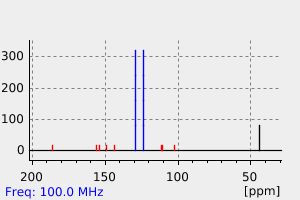3-amino-2-(4'-nitrobenzoyl)-5-(methylsulfonyl)thiophene-4-carbonitrile | 230310-91-5
中文名称
——
中文别名
——
英文名称
3-amino-2-(4'-nitrobenzoyl)-5-(methylsulfonyl)thiophene-4-carbonitrile
英文别名
4-amino-5-(4-nitro-benzoyl)-2-methylsulfonyl-3-thiophene-carbonitril;4-Amino-2-methylsulfonyl-5-(4-nitrobenzoyl)thiophene-3-carbonitrile
CAS
230310-91-5
化学式
C13H9N3O5S2
mdl
——
分子量
351.364
InChiKey
LPTHIFROWPQDFE-UHFFFAOYSA-N
BEILSTEIN
——
EINECS
——
-
物化性质
-
计算性质
-
ADMET
-
安全信息
-
SDS
-
制备方法与用途
-
上下游信息
-
文献信息
-
表征谱图
-
同类化合物
-
相关功能分类
-
相关结构分类
计算性质
-
辛醇/水分配系数(LogP):2.3
-
重原子数:23
-
可旋转键数:3
-
环数:2.0
-
sp3杂化的碳原子比例:0.08
-
拓扑面积:184
-
氢给体数:1
-
氢受体数:8
反应信息
-
作为反应物:描述:3-amino-2-(4'-nitrobenzoyl)-5-(methylsulfonyl)thiophene-4-carbonitrile 、 苯酚 在 sodium methylate 作用下, 以 甲醇 为溶剂, 反应 2.0h, 生成 4-Amino-5-(4-nitrobenzoyl)-2-phenoxythiophene-3-carbonitrile参考文献:名称:3-Amino-5-phenoxythiophenes: Syntheses and Structure−Function Studies of a Novel Class of Inhibitors of Cellular
l -Triiodothyronine Uptake摘要:A series of substituted 3-amino-5-phenoxythiophenes was synthesized starting from malodinitrile and carbon disulfide. The resulting dicyanoketenedithiolate reacts via Thorpe-Dieckmann cyclization with halogen methanes bearing electron-withdrawing groups to give thiophene-2-thiolates, which can be transformed into 3-amino-5-(methylsulfonyl)thiophene-4-carbonitriles. Replacement of the methylsulfonyl groups by substituted phenolates provides the substituted 3-amino-5-phenoxythiophenes. Some of the derivatives show a considerable inhibitory potency for the L-T-3 uptake in inhibition studies on human HepG2 hepatoma cells with maximum values of about 60% at a dose of 10(-5) M for the most potent 2-benzoyl derivatives. The structure of the phenoxythiophenes fits well into a general concept derived for other classes of L-T-3 uptake inhibitors, which postulates an angular and perpendicular orientation of the ring systems in these compounds as a prerequisite for an inhibitory potency. Docking studies for the phenoxythiophenes with transthyretin as a receptor model show their preferred attack at the L-T-4/L-T-3 binding channel.DOI:10.1021/jm980288r -
作为产物:参考文献:名称:3-Amino-5-phenoxythiophenes: Syntheses and Structure−Function Studies of a Novel Class of Inhibitors of Cellular
l -Triiodothyronine Uptake摘要:A series of substituted 3-amino-5-phenoxythiophenes was synthesized starting from malodinitrile and carbon disulfide. The resulting dicyanoketenedithiolate reacts via Thorpe-Dieckmann cyclization with halogen methanes bearing electron-withdrawing groups to give thiophene-2-thiolates, which can be transformed into 3-amino-5-(methylsulfonyl)thiophene-4-carbonitriles. Replacement of the methylsulfonyl groups by substituted phenolates provides the substituted 3-amino-5-phenoxythiophenes. Some of the derivatives show a considerable inhibitory potency for the L-T-3 uptake in inhibition studies on human HepG2 hepatoma cells with maximum values of about 60% at a dose of 10(-5) M for the most potent 2-benzoyl derivatives. The structure of the phenoxythiophenes fits well into a general concept derived for other classes of L-T-3 uptake inhibitors, which postulates an angular and perpendicular orientation of the ring systems in these compounds as a prerequisite for an inhibitory potency. Docking studies for the phenoxythiophenes with transthyretin as a receptor model show their preferred attack at the L-T-4/L-T-3 binding channel.DOI:10.1021/jm980288r
文献信息
-
[EN] THIOPHENE DERIVATIVES AS MICROBICIDES AND HERBICIDES<br/>[FR] DERIVES DE THIOPHENE COMME MICROBICIDES ET HERBICIDES申请人:BAYER CROPSCIENCE AG公开号:WO2004067527A1公开(公告)日:2004-08-12Novel thiophene derivatives of the formula (I) wherein R1, R2, R3 and n have the meanings given in the specification, several processes for the preparation of the new compounds and their use as microbicides and herbicides.
表征谱图
-
氢谱1HNMR
-
质谱MS
-
碳谱13CNMR
-
红外IR
-
拉曼Raman
-
峰位数据
-
峰位匹配
-
表征信息
同类化合物
(反式)-4-壬烯醛
(s)-2,3-二羟基丙酸甲酯
([1-(甲氧基甲基)-1H-1,2,4-三唑-5-基](苯基)甲酮)
(Z)-4-辛烯醛
(S)-氨基甲酸酯β-D-O-葡糖醛酸
(S)-3-(((2,2-二氟-1-羟基-7-(甲基磺酰基)-2,3-二氢-1H-茚满-4-基)氧基)-5-氟苄腈
(R)-氨基甲酸酯β-D-O-葡糖醛酸
(5,5-二甲基-2-(哌啶-2-基)环己烷-1,3-二酮)
(2,5-二氟苯基)-4-哌啶基-甲酮
龙胆苦苷
龙胆二糖甲乙酮氰醇(P)
龙胆二糖丙酮氰醇(P)
龙胆三糖
龙涎酮
齐罗硅酮
齐留通beta-D-葡糖苷酸
鼠李糖
黑芥子苷单钾盐
黑海棉酸钠盐
黑木金合欢素
黑曲霉三糖
黑介子苷
黄尿酸8-O-葡糖苷
麻西那霉素II
麦迪霉素
麦芽糖脎
麦芽糖基海藻糖
麦芽糖1-磷酸酯
麦芽糖
麦芽四糖醇
麦芽四糖
麦芽十糖
麦芽六糖
麦芽五糖水合物
麦芽五糖
麦芽五糖
麦芽五糖
麦芽三糖醇
麦芽三糖
麦芽三糖
麦芽三塘水合
麦芽七糖水合物
麦芽七糖
麦法朵
麦可酚酸-酰基-Β-D-葡糖苷酸
麦利查咪
麝香酮
鹤草酚
鸢尾酚酮 3-C-beta-D-吡喃葡萄糖苷
鸡矢藤苷







